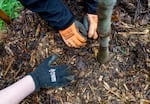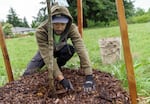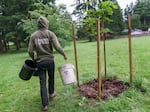Oregon’s tree population is about to get a lot larger. The state this week received more than $58 million in federal funds aimed at increasing tree canopy in community spaces and neighborhoods that most need to reduce the impacts of extreme heat.
The U.S. Department of Agriculture announced on Thursday the agency will dole out more than $1 billion to 385 projects nationwide. The goal is to increase equitable access to trees and nature, provide shade to neighborhoods that need it and reduce the effects of climate change.
Oregon’s portion will be dispersed between eight entities, including the city of Salem, Hermiston and the Oregon Department of Forestry.

Armani Thomas, a neighborhood tree specialist with the Friends of Trees, shows a group of students how to properly mulch and care for some big leaf maples planted at Columbia View Park in Gresham, July 6, 2022. Portland city officials ended their contract with Friends of Trees, which has helped plant tens of thousands of trees in the city.
Kristyna Wentz-Graff / OPB
The funds are part of the Inflation Reduction Act, the largest climate investment in the nation’s history, with more than $370 billion set aside for climate action. Part of the Inflation Reduction Act money is earmarked for disadvantaged communities, or communities most impacted by climate change, through the federal government’s Justice40 initiative which uses Census data to highlight overburdened and underserved communities.
ODF’s Urban and Community Forestry program manager Scott Altenhoff said the agency received nearly $23 million that will be spent on tree planting and maintenance.
Only two states received more funding than Oregon: California and New York.
Altenhoff said he is excited to see money for nature-based solutions to climate change like tree planting.
“We’ve known for many decades how critical green infrastructure exposure to trees and nature are for human wellbeing,” he said.
Altenhoff said tree planting offers short-, mid- and long-term solutions to reduce the impacts of climate change. He said $10 million will go to federally recognized tribes in the region.
ODF expects a formal application process for proposals will begin early next year.

Armani Thomas, a neighborhood tree specialist with the Friends of Trees, spreads mulch around a big leaf maple planted at Columbia View Park in Gresham, July 6, 2022. Portland city officials ended their contract with Friends of Trees, which has helped plant tens of thousands of trees in the city.
Kristyna Wentz-Graff / OPB
As the climate crisis continues, extreme weather events like heat waves are becoming more intense and happening more frequently throughout the nation. Most recently, the Southwest U.S. experienced several weeks of triple-digit temperatures, at times reaching more than 110 degrees Fahrenheit.
In Oregon, heat was brought to the forefront of the climate crisis when the deadly 2021 June heat dome event scorched the region, claiming the lives of 96 people in the state. Many of them were found in areas known as “urban heat islands,” places near concrete or industrial buildings with little to no tree canopy.
Portland State University professor Vivek Shandas said the massive investment in tree planting is a recognition that the federal government sees a connection between climate solutions and trees.
During the June 2021 heat dome, Shandas visited different Portland neighborhoods to record how hot it gets in those areas. He found there was at least a 20-degree difference between neighborhoods with tree canopies and neighborhoods surrounded by industrial buildings.
Shandas, who studies climate change adaptation and urban heat, said trees were often used to aesthetically improve a home or neighborhood rather than its health benefits.
He said he’s hopeful the federal spending will continue as the nation prepares to plant hundreds of millions of trees.
“Over the next few years and over time, those hundreds of millions of trees will grow and appreciate in value and really take pollutants out of the air,” he said. “They will provide tremendous shade. There will likely be a rapid decline in mental and physical health challenges as a result of all these trees.”

Armani Thomas, a neighborhood tree specialist with the Friends of Trees, finishes mulching and inspecting some big leaf maples planted at Columbia View Park in Gresham, July 6, 2022. Portland city officials ended their contract with Friends of Trees, which has helped plant tens of thousands of trees in the city.
Kristyna Wentz-Graff / OPB
Friends of Trees, a nonprofit organization focused on tree planting and improving urban tree canopy and restoration, also received federal funds. The organization, along with a coalition of 11 other community and environmental groups, received $12 million that will go toward community tree planting and maintenance in East Multnomah County, West Eugene and Springfield.
“We have a lot of challenges. We have a lot of heat island issues,” Friends of Trees executive director Yashar Vasef said. “We’re seeing this as a pivotal moment to kind of scale up meaningful climate change work and to bring all the communities within this proposal the benefits of trees.”
Vasef said trees have many physical and mental health benefits for the public, like providing potential life-saving shade to cool down on a hot day, removing pollutants from the air and sequestering carbon to reduce greenhouse gas emissions. He said trees also provide benefits to animals around them.
Vasef said as these new trees go into place, they will need continued investment to help them survive. About 30 trees planted two years ago in East Portland died in August from a lack of water, according to Willamette Week.
Vasef said Friends of Trees works with community members to help trees survive “especially those first few critical years and surviving our droughts and heatwaves in the summers.”
